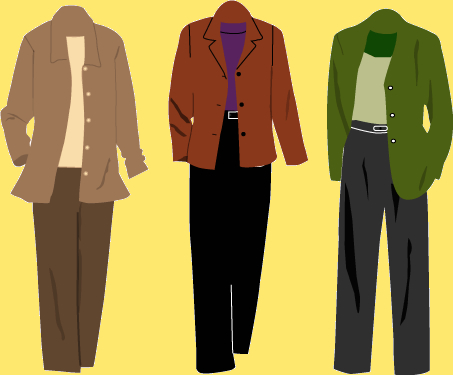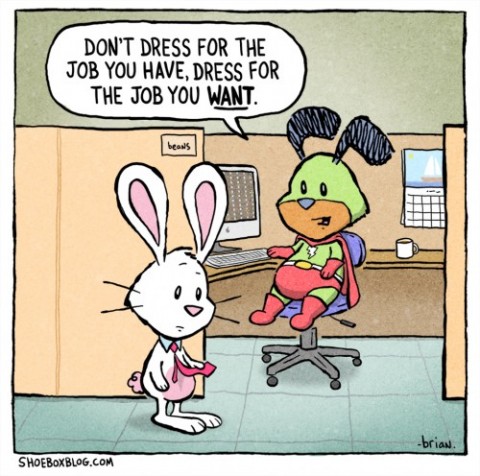We all worry about what to wear to our professional commitments such as job/grad school interviews, seminars, and scientific meetings. It is important to come across as professional, and dressing neatly and appropriately also shows respect and lets people know we are serious. But, how do we do that? See a good discussion on the BU Center for Career Development web page. Also:
Some general rules:
1) In general, scientists and academics dress just a little more casually than do people in industry, business, law, and government. Tailor your choices to where you are going.
2) If at all possible, find out what people usually wear in the situation you are dressing for, and then shade your clothing choice a little more formal than that. For example, if you are interviewing for a job at which most people wear a teeshirt and jeans to work, you could wear a shirt with a collar and khakis for an interview. But, clearly a tie and jacket would be too formal in this situation.
3) Whatever you are wearing, it must be clean, neat, unstained, unfrayed, unwrinkled, have no holes, and fit you.
4) Don’t wear shorts unless you are interviewing for a job in Bermuda.
5) If you have tattoos or piercings, remember that you might be talking with someone who hates them. So, cover them or otherwise minimize them.
6) Once you have figured out what you are going to wear, practice wearing it so that you will feel comfortable.
7) Once you are established in a job, grad school, or career, you may be able to express your individual style (depending on the position, of course)—but not in an interview, seminar, etc.
Rules for women:
 1) No cleavage. No spagetti straps. In fact, consider choosing clothes that cover your shoulders, arms, and legs. Sleeveless is not a becoming look for many people, and also unprofessional. Your goal is to eliminate disctractions--you want people to be thinking about how competent you are, not how you look.
1) No cleavage. No spagetti straps. In fact, consider choosing clothes that cover your shoulders, arms, and legs. Sleeveless is not a becoming look for many people, and also unprofessional. Your goal is to eliminate disctractions--you want people to be thinking about how competent you are, not how you look.
2) If you wear a skirt, it must be long enough and loose enough that you can sit, stand, or pick up your bag from the floor, and not show thighs, without having to think about it. This is particularly important if you will be sitting in front of an audience! Practice sitting in front of a mirror to see how you will look.
3) Better: wear pants. Recent female job candidates for faculty positions at OSU all chose to wear pants. In fact, they all chose dark or black pants with a jacket or cardigan over a colored top, with low-heeled shoes (see picture). For business attire, try a more formal jacket over a simple unrufffled blouse or top and pants or skirt.
4) No cocktail attire or party dresses. It may be your favorite dress and you may look great in it, but it’s not appropriate for giving a talk or having a job interview. If it’s black or shiny or glittery, or has a low neck or straps, it may be cocktail attire. Save it for evening events. If you are going to a scientific meeting, there probably will be evening events (but remember, you might be sitting with your potential boss at the evening event, so bring a somewhat modest choice of clothing just in case you need it).
5) Under pants, flat shoes or low heels (1” - 2”) look professional. Higher or spike heels are more likely to be worn in industry, government and the law that in academia, so tailor your choice to where you are going. You don’t want to trip or get sore feet, so make sure you can move easily in your choice of shoes and that they won’t hurt if you have to wear them all day. Avoid white or light-colored shoes. If you are wearing a skirt, wear nylons/pantyhose/tights—no bare legs. Don't wear white socks with dark pants and shoes.
6) Make sure your clothes aren’t tight. They should hang down with no wrinkles or pulls.
7) Wear quiet colors. Avoid very bright colors and most patterns. On the other hand, if most of your outfit is black or navy, try to add some color (your top, etc.) so that you won’t look like you are interviewing for a job in the funeral industry.
8) Your jewelry should be small and unobtrusive, and your makeup and hair should be muted and non-distracting. Make sure your hair does not fall in your face or cover your eyes.
9) You may not own any clothes that fit these criteria. You can borrow them, as long as they fit you, OR check Goodwill, consignment stores, and the like—lots of inexpensive choices, and recycling is good! Ross and Marshall’s are also good. If you have to spend money, try to find something so basic that you will be able to wear it again for another interview.
Rules for men:
1) Your high school graduation suit may not be appropriate for a job interview or seminar unless you are interviewing for a position in the funeral industry. It may not even fit you very well any more. Perhaps you could wear the pants with a nice shirt, if you are going formal.

2) It’s a good idea to find out whether the men usually wear ties at the place you are interviewing, giving a talk, making a scientific presentation, etc. You might feel uncomfortable if you wear a tie and no one else is. Try to talk to someone who has been there, look online, etc. Ties roll up small—take one with you in case, if you are not sure. (Nice ties are really cheap at Goodwill.)
3) Casual: a shirt with a collar, slacks/khakis. Slightly more dressy: add a tie, or a nice (plain, quiet colored) sweater if it’s cold. Slightly more dressy: add a jacket (but not a suit). Pretty formal, rarely needed: a suit. People wear jeans in some situations, but don’t assume jeans are going to be all right. You can always change into jeans for the second day of the meeting or interview, if everyone else is wearing them.
4) Choose quiet colors, unless you are interviewing for a job in the athletic gear industry.
5) Avoid jewelry, or keep it small and quiet. If your pants have belt loops, wear a belt. Make sure your hair is neat and does not fall in your face or get in your eyes. Shave! Or if you wear a beard and/or mustache, make sure they are neatly trimmed.
6) If you need to find out your shirt size, go to a department store with a men’s clothing department and ask them to measure you.
7) Look for a pair of leather shoes, or something plain that’s not running shoes, and make sure they are clean and polished (and comfortable, if you will stand all day). Black shoes are considered to go well with black or navy or gray. Brown shoes are considered to go well with khaki or brown, and are also less formal than black shoes. With either black or brown shoes, wear dark socks that match each other--not white.
8) Again, shop Goodwill, consignment stores, and the like for these clothes. Make sure everything fits, no bits of skin show, and there are no missing buttons. Ross and Marshall’s have inexpensive shirts (once you know your size), belts, etc. Don’t forget you will need dark socks.

Left: Not a good choice of outfit for a job interview--although, at least s/he has clean feet!
